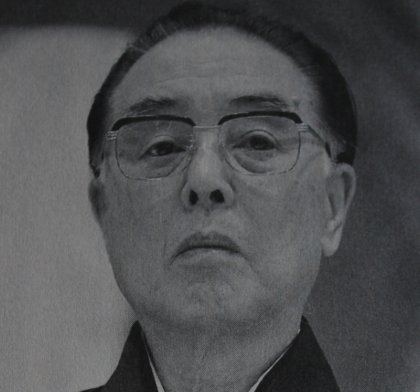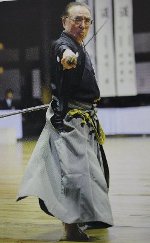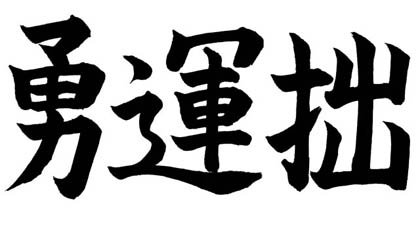Iaido is see and cut an invisible opponent
 Here is a rough chapter translation of the book titled “Iaido shinsain no me” we introduced some post ago. It is now time to publish this chapters that is is a part of the Ueno Satanori – 8th dan Hanshi Iaido – section. The chapter we choose is the third chapter “Iaido is see and cut an invisible opponent”
Here is a rough chapter translation of the book titled “Iaido shinsain no me” we introduced some post ago. It is now time to publish this chapters that is is a part of the Ueno Satanori – 8th dan Hanshi Iaido – section. The chapter we choose is the third chapter “Iaido is see and cut an invisible opponent”
“See and cut an invisible opponent”
Whereas in Kendo the opponent is visible, in Iaido the opponent is Kaso teki – An invisible opponent. We can not see him but we have to materialize him and cut where he is supposed to be. This is one of the most important Iaido concept. To cut an area where the enemy has not been materialized has no meaning/sense and is only complacency. I think that even if the enemy is not real we have to deeply imagine where he is and realize what he is doing -> That is what gives a meaning/sense to our practice.
Until approximately 3rd dan the requirements are: the correct body movements orders knowledge, have a general idea of the enemy location, what distance to move while doing the nukitsuke/kiritsuke, where to cut (height of the kissaki). That is why for that level the examination juries will mainly check the ZKR Iai book points.
For 4th and 5th dan the juries will take a closer look to the practitioner’s relationship with the enemy, to his perception of the enemy. For this level it becomes essential to know the exact position, intentions and rhythm of the enemy by closely reading the ZKR Iai book and refining his understanding of the different kata’s riai – story – and train accordingly.
For examination above 5th dan you have to clearly demonstrate the riai (story logic) and actions accuracy while performing katas. Show that you are correctly responding to the various enemy’s location, distance, timing, intentions and through this -> materialize the enemy’s presence.
Myself for my 7th dan. I was seized by a remark from Kamimoto Eiji sensei: “How can you cut without seeing your enemy ?” At that time I was only following the movement’s order. Thinking yourself “If I cut at the wrong place, I will be killed” is the only way to work seriously and convince a jury.
I have been judging 8th dan examination until 2007 and my main check point was focused on candidate’s breathing technique. Correct breathing flow (Kokyu) is essential to master Heijoshin and if you can maintain Heijoshin then it will be more easy to focus and materialize the enemy. Mind/Hearth confusions impact kata’s execution and influence the Hin-i (Dignity) and Fukaku (Depth of personal character – Style). What improves the hin-i and fukaku, is I think, being able to maintaining this Heijo state.
Humans usually breathe with their chest (torso), but in Iaido, we are taught to breathe using the hara (Ed. Lower tanden). What helped me to develop a good breathing method was the practice of Shigin – chanted Japanese poetry – If one recites a shigin having thoroughly inspired voice tightens and does not persist. If one inspires only 7/10, the voice that comes out of the abdomen is extended. It’s the same thing in iaido. It is inspiring to 6 or 7 tenth and exhaling slowly through the stomach. It allows to operate the breath from the abdomen by pushing the inspired air to the bottom and leaving this part of the abdomen slightly forward.
 Finally, I will discuss about “Okuiai”. Our Iaido elders have defined an efficient, logical and technical structure in order to learn/master Iaido. This structure is the different levels Shoden / Chuden / Okuden. The most important point is to understand and assimilate the essence/substance of Iaido. It is important to first master basis.
Finally, I will discuss about “Okuiai”. Our Iaido elders have defined an efficient, logical and technical structure in order to learn/master Iaido. This structure is the different levels Shoden / Chuden / Okuden. The most important point is to understand and assimilate the essence/substance of Iaido. It is important to first master basis.
Of course an iaido action is useless in a real combat if not done with speed, however, going quickly without satisfying the ki-ken-tai icchi and other basis is useless. It is only after having thoroughly studied and fully polished (Renshu) his Shoden and Chuden level that one can understand the essence of okuiai. Speed should be a natural consequence of learning thoroughly basis through repetition.
The perception of the extraordinary of “ken shin ichi nyo” ( 剣 心 一如 / Sword and Mind as one) only comes once the body and sword technique allow the react anywhere, anytime.
Y. & M.
** Please bare in mind that we are no professional translators and that our translation may contain errors. Note that the above translation is not a word for word one and its goal is to give a general idea of the content.
This article was originally published in a book called “Shinsa-In No Me” (The Eye of the Examiner) and it is with kind permission of the publisher Taiiku and Sports Co. http://www/taiiku-sports.co.jp that we are able to provide these to all for free circulation.
Please note:
1. These essays are the property of Taiiku and Sports Publishing Co. who have kindly allowed them to be freely distributed.
2. They may be copied but must remain in the format shown.
3. The articles may be not be sold or used in any way for financial gain.
4. The articles may not be altered without express permission of the publisher. **
Posted: October 28th, 2010 under Iaido.
Tags: Fukaku, Heijoshin, Kaso teki, Kasso teki, Okuiai, Shinsain no me, Ueno Satanori



